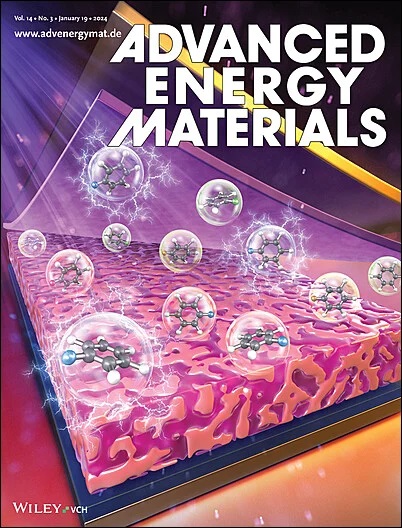扩散场变化对氧还原途径中反应物和中间体吸附的影响
IF 24.4
1区 材料科学
Q1 CHEMISTRY, PHYSICAL
引用次数: 0
摘要
酸性电解质中铂(Pt)电极上的氧还原反应(ORR)可以通过两种途径发生,其中四电子途径通常占主导地位。虽然现有的许多文献都集中在结构-活性关系上,以解释这些途径之间的转换,但介观质量传输的影响-特别是与扩散场的变化相关的影响-受到的关注有限。在这项研究中,Pt纳米颗粒的负载被系统地改变,以创造具有相似的物理化学性质,但不同的粒子间距离(IPD)的材料。电化学阻抗谱分析表明,粒子间距离的改变显著改变了O2的扩散场,从而影响了H2O2的吸附并决定了反应途径。值得注意的是,将IPD从58.6 nm增加到117.0 nm,酸性条件下H2O2选择性从4.6提高到81.5%。这些发现强调了扩散场修饰在影响反应物和中间体吸附方面的关键作用,从而形成了电催化的机制。本文章由计算机程序翻译,如有差异,请以英文原文为准。

Influence of Diffusion Field Alterations on Reactant and Intermediate Adsorption in Oxygen Reduction Pathways
The oxygen reduction reaction (ORR) on platinum (Pt) electrodes in acidic electrolytes can occur via two pathways, with the four‐electron pathway typically dominating. While much of the existing literature has focused on structure‐activity relationships to explain the switching between these pathways, the influence of mesoscopic mass transport—specifically related to modifications in the diffusion field—has received limited attention. In this study, the loading of Pt nanoparticles is systematically varied to create materials with comparable physicochemical properties but differing interparticle distances (IPD). Electrochemical impedance spectroscopy revealed that modifications in interparticle distance significantly alter the O2 diffusion field, which subsequently impacts the adsorption of H2 O2 and dictates the reaction pathways. Notably, increasing the IPD from 58.6 to 117.0 nm led to a substantial increase in H2 O2 selectivity in acidic conditions, rising from 4.6 to 81.5%. The findings highlight the pivotal role of diffusion field modifications in influencing reactant and intermediate adsorption, thereby shaping the mechanisms of electrocatalysis.
求助全文
通过发布文献求助,成功后即可免费获取论文全文。
去求助
来源期刊

Advanced Energy Materials
CHEMISTRY, PHYSICAL-ENERGY & FUELS
CiteScore
41.90
自引率
4.00%
发文量
889
审稿时长
1.4 months
期刊介绍:
Established in 2011, Advanced Energy Materials is an international, interdisciplinary, English-language journal that focuses on materials used in energy harvesting, conversion, and storage. It is regarded as a top-quality journal alongside Advanced Materials, Advanced Functional Materials, and Small.
With a 2022 Impact Factor of 27.8, Advanced Energy Materials is considered a prime source for the best energy-related research. The journal covers a wide range of topics in energy-related research, including organic and inorganic photovoltaics, batteries and supercapacitors, fuel cells, hydrogen generation and storage, thermoelectrics, water splitting and photocatalysis, solar fuels and thermosolar power, magnetocalorics, and piezoelectronics.
The readership of Advanced Energy Materials includes materials scientists, chemists, physicists, and engineers in both academia and industry. The journal is indexed in various databases and collections, such as Advanced Technologies & Aerospace Database, FIZ Karlsruhe, INSPEC (IET), Science Citation Index Expanded, Technology Collection, and Web of Science, among others.
 求助内容:
求助内容: 应助结果提醒方式:
应助结果提醒方式:


